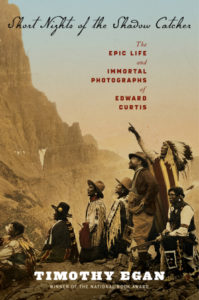Edward Sheriff Curtis, a grade-school drop-out, started his career in Seattle where he opened a photography studio. He was drawn to an old Indian woman who, by law, wasn’t even supposed to live in town, even though the city was named after her father, Chief See-ahlsh. Although often tormented by rock-throwing school boys and barely tolerated by Seattle citizens, Princes Angeline, the name given her because her real name was unpronounceable, refused to leave. Curtis finally talked her into letting him take her photograph at his Seattle studio. The photograph, taken in 1896, is remarkable in its detail.
Edward Curtis’s ambition was to produce a 20-volume publication of Native American communities in the early 20th Century. Even today, the logistics of such a project would be daunting, but considering the hardships involved—difficult travel, language barriers, bulky equipment—it was a remarkable achievement. In quest of his project, he enlisted the help of the day’s big thinkers, including President Theodore Roosevelt. Even so, he was constantly plagued by lack of funds. He received no personal pay for his life’s work; all monies went into the production of the publication.
Curtis spent three decades documenting the stories, rituals, and even some languages of more than eighty North American tribes. It took tremendous energy. The title of the book “Short Nights” hints to this–Curtis rarely slept. The “Shadow Catcher” was the name Native Americans gave to him.
The undertaking influenced Curtis profoundly. He became an outraged advocate of the American Indian’s plight: the broken treaties, missionaries “misguided missions,” the deplorable treatment of innocent women and children by the U.S. Army.
Short Nights of the Shadow Catcher: The Epic Life and Immortal Photographs of Edward Curtis features many of the Curtis photographs, and they are stunning. The limited 20-volume publications, The North American Indian, produced between 1907 and 1930 are highly valued today and are considered a “literary, artistic, historical masterpiece.” In appearance and texture, the books are among the most luxurious ever printed.
Author Timothy Egan, Pulitzer Prize-winning writer for the New York Times and best-selling author of seven books, has written a riveting biography. Short Nights of the Shadow Catcher is a well-told story of Edward Curtis, a remarkable man who has enriched our understanding of the Native American.


